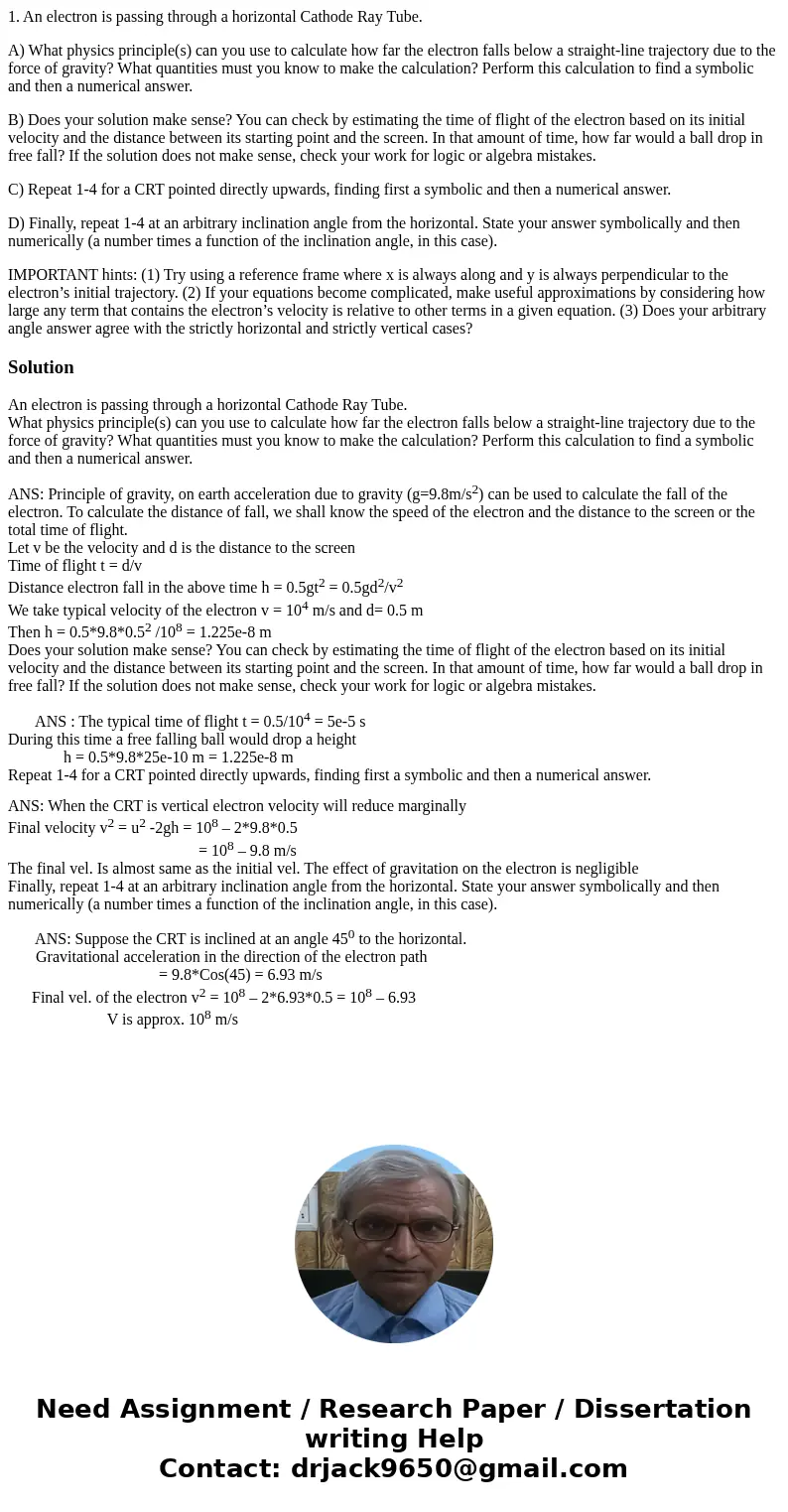1 An electron is passing through a horizontal Cathode Ray Tu
1. An electron is passing through a horizontal Cathode Ray Tube.
A) What physics principle(s) can you use to calculate how far the electron falls below a straight-line trajectory due to the force of gravity? What quantities must you know to make the calculation? Perform this calculation to find a symbolic and then a numerical answer.
B) Does your solution make sense? You can check by estimating the time of flight of the electron based on its initial velocity and the distance between its starting point and the screen. In that amount of time, how far would a ball drop in free fall? If the solution does not make sense, check your work for logic or algebra mistakes.
C) Repeat 1-4 for a CRT pointed directly upwards, finding first a symbolic and then a numerical answer.
D) Finally, repeat 1-4 at an arbitrary inclination angle from the horizontal. State your answer symbolically and then numerically (a number times a function of the inclination angle, in this case).
IMPORTANT hints: (1) Try using a reference frame where x is always along and y is always perpendicular to the electron’s initial trajectory. (2) If your equations become complicated, make useful approximations by considering how large any term that contains the electron’s velocity is relative to other terms in a given equation. (3) Does your arbitrary angle answer agree with the strictly horizontal and strictly vertical cases?
Solution
An electron is passing through a horizontal Cathode Ray Tube.
What physics principle(s) can you use to calculate how far the electron falls below a straight-line trajectory due to the force of gravity? What quantities must you know to make the calculation? Perform this calculation to find a symbolic and then a numerical answer.
ANS: Principle of gravity, on earth acceleration due to gravity (g=9.8m/s2) can be used to calculate the fall of the electron. To calculate the distance of fall, we shall know the speed of the electron and the distance to the screen or the total time of flight.
Let v be the velocity and d is the distance to the screen
Time of flight t = d/v
Distance electron fall in the above time h = 0.5gt2 = 0.5gd2/v2
We take typical velocity of the electron v = 104 m/s and d= 0.5 m
Then h = 0.5*9.8*0.52 /108 = 1.225e-8 m
Does your solution make sense? You can check by estimating the time of flight of the electron based on its initial velocity and the distance between its starting point and the screen. In that amount of time, how far would a ball drop in free fall? If the solution does not make sense, check your work for logic or algebra mistakes.
ANS : The typical time of flight t = 0.5/104 = 5e-5 s
During this time a free falling ball would drop a height
h = 0.5*9.8*25e-10 m = 1.225e-8 m
Repeat 1-4 for a CRT pointed directly upwards, finding first a symbolic and then a numerical answer.
ANS: When the CRT is vertical electron velocity will reduce marginally
Final velocity v2 = u2 -2gh = 108 – 2*9.8*0.5
= 108 – 9.8 m/s
The final vel. Is almost same as the initial vel. The effect of gravitation on the electron is negligible
Finally, repeat 1-4 at an arbitrary inclination angle from the horizontal. State your answer symbolically and then numerically (a number times a function of the inclination angle, in this case).
ANS: Suppose the CRT is inclined at an angle 450 to the horizontal.
Gravitational acceleration in the direction of the electron path
= 9.8*Cos(45) = 6.93 m/s
Final vel. of the electron v2 = 108 – 2*6.93*0.5 = 108 – 6.93
V is approx. 108 m/s

 Homework Sourse
Homework Sourse